Rachael Dickzen's Blog, page 15
September 30, 2019
The Historical and Pop Cultural Inspirations in the Costumes of Six the Musical: Wives 1-3
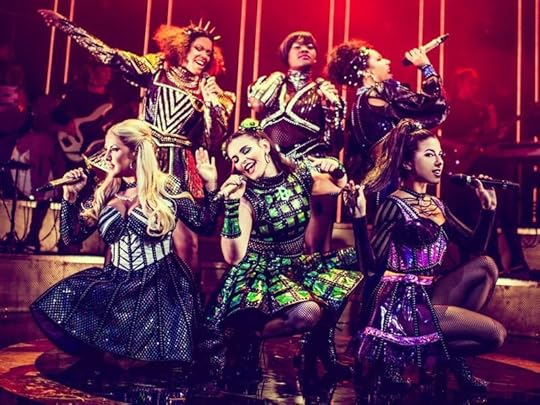
From top left, clockwise - Catherine of Aragon (Jarneia Richard-Noel), Anne of Cleves (Alexia McIntosh), Catherine Parr (Maiya Quansah-Breed), Catherine Howard (Aimie Atkinson), Anne Boleyn (Millie O’Connell), Jane Seymour (Natalie Paris). (Idil Sukan, the West End cast).
So I’ve gotten pretty obsessed with the musical Six lately, which is based on the lives of the six wives of Henry VIII. It’s set up as a girl group pop concert, in which the six women each sing the stories of their lives.
I’ve been dying for more information about the costumes in the show and haven’t been able to find a ton of information. The costume designer, Gabriella Slade, was nominated for an Olivier award for her work. In one article, she said:
“It was an amazing brief. There needed to be an echo of Tudor fashion, but obviously the contemporary influence of the pop industry. It’s an amazing thing to be able to infuse period costume with contemporary style. Lucy [Moss, writer] had ideas about which pop stars related to which queens. Catherine of Aragon is Beyoncé, Jane Seymour is Adele, Catherine Parr is Alicia Keys, Catherine Howard is Ariana Grande, Anne Boleyn is Lily Allen and Anne of Cleves is Nicki Minaj meets Rihanna.”
Other than that though, I haven’t been able to find a lot about her process or inspiration in designing these costumes. So I decided to look into the costumes myself. I’ll be directly comparing them to their historical counterparts and their modern pop artist inspirations.
These are all just educated guesses (based on lots and lots of reading and photo/portrait examining), but I am by no means a fashion or a pop music expert! If you have any contributions or comments, please send them my way - via the comments here, Twitter, or email at Rachael.Dickzen@gmail.com. I’d love to hear what you have to say!
This will be the first of three posts on the costumes in Six. Second post will be Wives 4-6 and the Third will take a look at the alternates’ costumes! I hope to get those both out within the next week or two.
Historical Note: Spelling wasn’t standardized in Tudor times, so you’ll see these Queens’ names spelled a number of different ways.
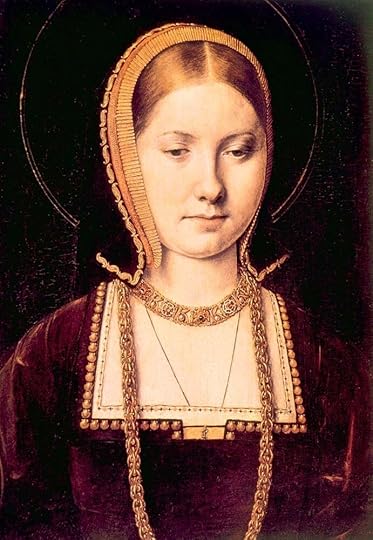
Portrait of a noblewoman, traditionally considered Catherine of Aragon c. 1502 (but also could be Mary Tudor), by Michael Sittow.
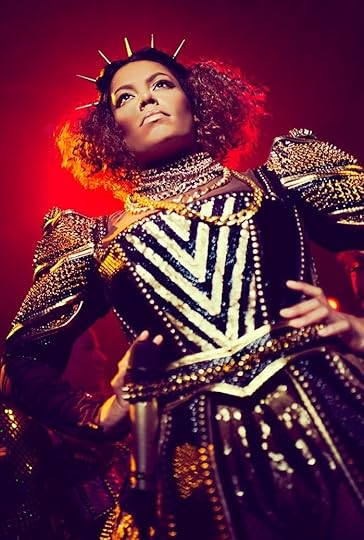
Catherine of Aragon, portrayed by Jarneia Richard-Noel. (Idil Sukan)
My name is Catherine of Aragon
Was married 24 years, I'm a paragon
Of royalty, my loyalty is to the Vatican
So if you try to dump me
You won't try that again
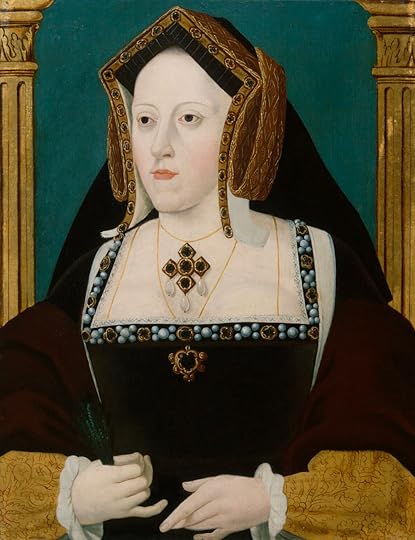
Unknown artist, oil on panel, early 18th century (copy of a lost original portrait)
Catherine of Aragon was a Spanish princess, the youngest child of the famous Ferdinand and Isabella (yes, the same ones who sent Christopher Columbus out on his fun genocidal adventure, but THAT’S another blog post). She was Queen of England from June 1509 - May 1533.
She was betrothed to Henry’s older brother Arthur, Prince of Wales, when she was three years old and married him when they were both 16. However, he died in 1502, only a few months after they married.
What movies/TV shows don’t often tell you about Catherine of Aragon was that she had a HELL of a hard time after Arthur died (The Spanish Princess on Starz got a /bit/ into this, but didn’t fully explore the length of this time in her life. Henry was TEN when she married his brother). By the terms of her marriage contract, if she returned home to Spain, King Henry VII had to return her 200,000 ducat dowry (half of which he hadn’t even received yet). King Henry was broke and totally couldn’t afford this. He briefly considered marrying her himself (after his wife Elizabeth of York died in 1503 after trying to give him another son to replace Arthur), but eventually it was decided that she would marry Henry, Duke of York. However, he was five years younger than her, so they had to wait for him to grow up. His father also continually delayed their marriage. For the next seven years, Catherine lived in near-poverty in London, trapped between her father and her father-in-law. She had to sell many of her goods to survive and was not often seen at court due to the shabbiness of her clothes.
She finally married Henry after his father’s death and his ascension to the throne in 1509. They were married for the next 24 years and for many years, they appeared to be quite in love. Catherine got pregnant seven times but most of her children either miscarried or stillborn; only three survived the birth, and only one, Princess Mary, survived past two months of life. Catherine was always known as a highly intelligent and religious woman, but as more and more of her children died, she became increasingly devout and more interested in academic matters, particularly in ensuring the education of her daughter.
After Henry became obsessed with Anne Boleyn and his all-consuming desire to have a son, he attempted to get his marriage to Catherine annulled on the basis that she was his brother’s wife first. He also asked Catherine to retire to a nunnery. She steadfastly refused all efforts to put her aside and maintained until her death that she was Henry’s rightful queen and wife. Because of her stubbornness, Henry moved her out of his household and into increasingly shabbier and more isolated homes. He also refused to let her see her daughter, Mary. By the time she died in 1535 (probably of cancer), she likely had not seen her daughter for three or so years.
Catherine’s daughter Mary eventually became England’s first queen regnant and ruled the country for five years.
Historical Influences: The costume has some pretty direct homages to Catherine of Aragon’s portrait as a young woman. You can see that in the gold chains and gold grommeting around the collar, the square neckline, and the overall color scheme of the costume. In addition, Catherine somewhat famously had auburn hair, which is clearly shown in at least this actress’s hair. There are fewer similarities to her second portrait, but I’ve included it anyway. This portrait too, though, features a dark dress with a square neckline and touches of gold. The gold throughout the Six costume could also be referencing the wealth of Spain and her royal credentials.
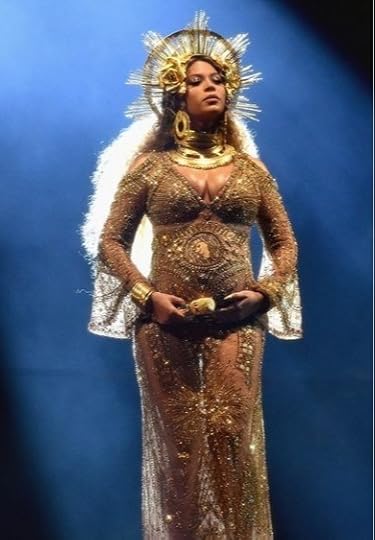
Beyonce at the 2017 Grammys (Getty Images for NARAS)
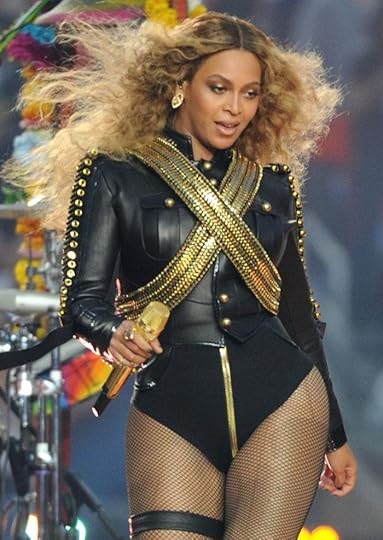
Beyonce at the Super Bowl 2016 (Christopher Polk/Getty Images)
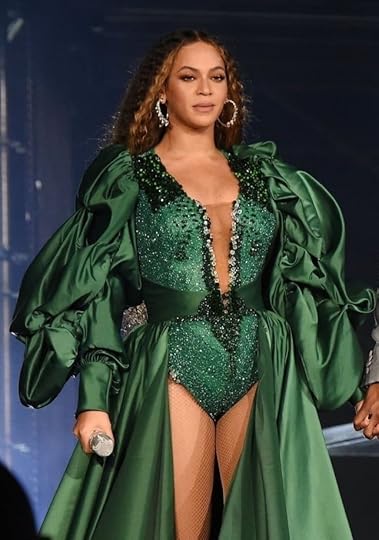
Beyonce in 2018 (Kevin Mazur/Getty Images)
Pop Culture Influences: The character of Catherine is supposed to be inspired by Beyonce, which comes across pretty clearly in her song “No Way.” Stylistically, it fits with Beyonce’s more melodic songs (like “Irreplaceable,” below), and content-wise, the righteous anger throughout reminds me a lot of some of the songs on the brilliant “Lemonade” album (see “Sorry”).
I also think you can see hints of Beyonce in the costume - particularly in the gold “crown” in her hair. The character’s hair (which appears to be a wig, from videos and photos I’ve seen) is very similar to Beyonce’s, albeit shorter (it does appear that the character’s hair started out a lot longer and then was cut down in both volume and length over time). In addition, the overall cut and strong silhouette of the outfit really seems influenced by Beyonce’s style.
I did find a video in which one of the Aragon actresses said she considered Shakira an inspiration for the character as well, but I’m not really finding any Shakira outfits that are similar to this costume at all. I’m guessing that’s really more of a musical inspiration, as there is a definite Latin beat to Aragon’s song, which represents her Spanish heritage.
Accessories Note: Only two queens in the musical have crown-like spikes in their hair, Catherine of Aragon and Anne of Cleves. This may be because their historical counterparts were royal /before/ marrying Henry VIII.
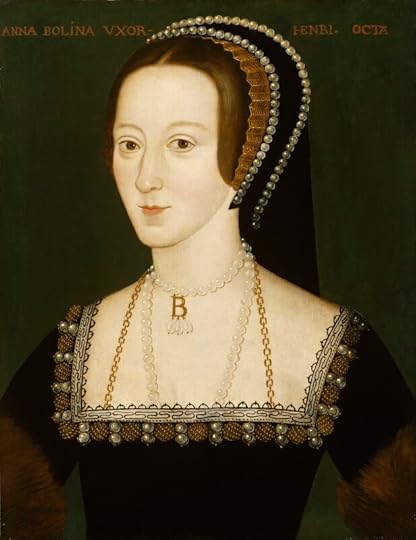
Anne Boleyn, by Unknown English Artist, oil on panel, late 16th century, based on a work of circa 1533-1536
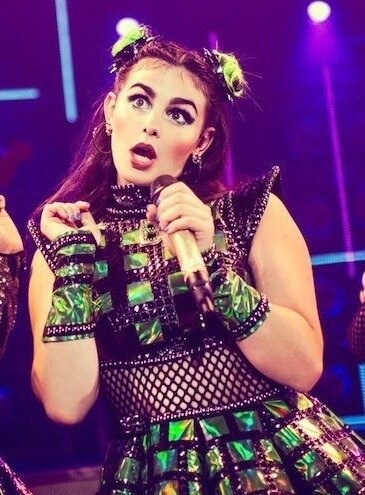
Anne Boleyn, portrayed by Millie O’Connell. (Photographer Unknown)
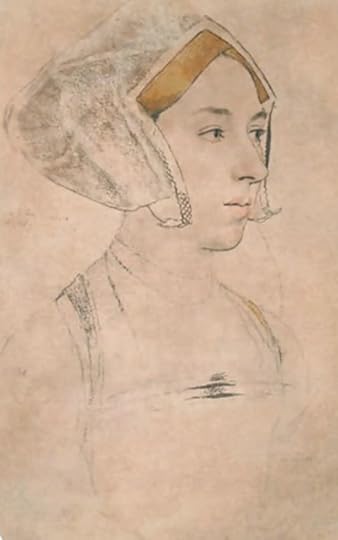
Portrait of a Lady, thought to be Anne Boleyn, by Hans Holbein
I’m that Boleyn girl
And I’m up next, see
I broke England from the Church
Yeah, I’m that sexy
Why did I lose my head?
Well, my sleeves may be green
But my lipstick’s red.
Anne Boleyn - Henry’s second wife (who was queen from May 1533- May 1536) is probably the most well-known and notorious, as she was the victim of a vicious propaganda campaign that has lasted for so long that even well-educated people these days will refer to her as a whore. And honestly, I think you can see a lot of that propaganda even in her song from Six, which characterizes Anne as “just tryin’ to have some fun,” which is in my opinion, tremendously unfair to the brilliant woman she really was. I will write a FULL TED TALK LECTURE worth of opinions for a blog post later, but I should probably give you a brief overview so we can talk about the costumes now, yeah?
Anne Boleyn was Henry’s first English wife, the daughter of a highly respected diplomat and a noble lady from the Howard family (the daughter of the Duke of Norfolk). She was by no means a “commoner,” but she certainly wasn’t a princess like Catherine of Aragon. Anne was considered so precocious and talented that at age 12 (or possibly younger!), she was invited to join the court of Margaret of Austria. In her youth, she also was a maid of honor to Mary Tudor, the new Queen of France, and Queen Claude, the even newer Queen of France (Maids of Honor were young, unmarried noblewomen who attended on women of higher rank). Here, Anne was almost certainly exposed to the ideas of both Renaissance humanism and courtly love (which I’ll explain more in a later post, but didn’t actually involve any physical love), which influenced a lot of her later actions and words.
Anne was recalled to England to marry a cousin to settle a land dispute, but this plan fell through. She went on to the English court to serve Catherine of Aragon and became known as a tremendously charming, intelligent, and quick-witted woman. Henry VIII began pursuing Anne in 1526, but we know from his love letters to her throughout their seven-year courtship that their affair remained unconsummated for a very long time. Both Henry and Anne assumed that his marriage could be annulled fairly easily, as the Pope had granted annulments to several Kings in the past without much fuss. However, Catherine’s connections to the Holy Roman Emperor Charles (her nephew) ensured that this did not happen, and Henry would eventually have to break with the Catholic Church and form the Church of England to get his longed-for annulment. By the that time, most of England and Europe hated Anne and called her a whore. A mob of Londoners actually attacked her during dinner once; she barely got away.
Henry and Anne did eventually get married, after she was already pregnant with the future Princess Elizabeth. By all accounts, she was a doting mother and frequently visited her daughter (and thus, I’m pretty annoyed that Anne’s song in Six literally doesn’t even mention Elizabeth, even though Aragon’s and Seymour’s songs mention their kids). Anne was paranoid for her safety and the safety of her child, and when Henry began pursuing other women at court, she lost her temper at the king publicly several times. Her anger at seeing Henry with Jane Seymour may have led to her final miscarriage.
It’s a bit unclear who actually orchestrated Anne’s downfall - it may have been Henry’s chief minister Thomas Cromwell (although there were numerous sloppy mistakes in the falsified evidence, which seems too careless for Cromwell, IMO). But in the end, Anne would be tried and convicted of high treason due to adultery with five men, including her own brother. All six of the accused were arrested and executed in late April- mid-May 1536. There’s really no evidence supporting any of the charges and historians widely believe that the charges were completely manufactured.
In a final fuck you from the grave though, Anne’s daughter Elizabeth I would ultimately become one of England’s greatest monarchs. She reigned for over 40 years in a golden age of progress and led England to becoming a great world power.
Historical Inspiration: The historical inspiration for this costume is more subtle, but you can still see a few touches. The beading in Anne’s dress is reflected in the silver grommets in the modern costume. The actress also has Anne’s famous dark hair and eyes. Her blush even looks like it might be applied to match Anne’s? And of course, there’s the giant “B” necklace. The green of the costume appears to be tied to the legend that Henry VIII wrote “Greensleeves” about Anne, which is referenced several times in the musical’s soundtrack.
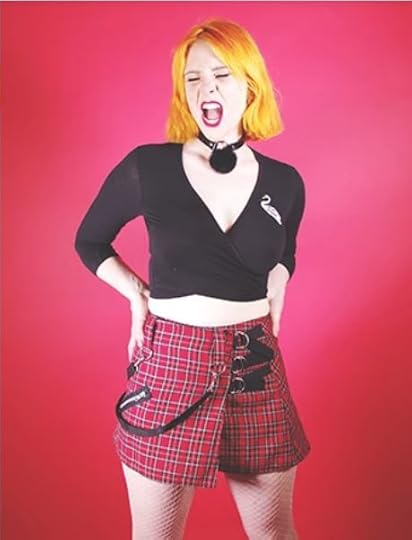
Kate Nash
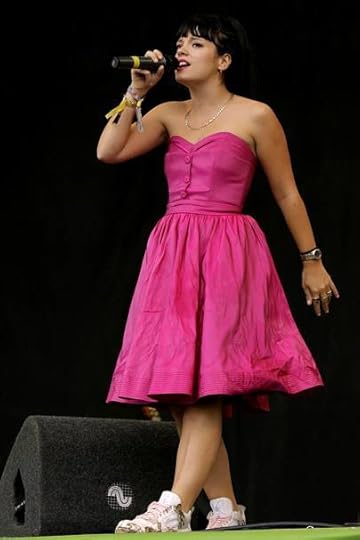
Lily Allen
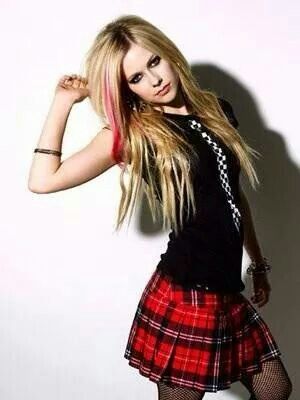
Avril Lavigne
Pop Culture Inspirations: Anne is supposed to be inspired by Lily Allen, Avril Lavigne, and Kate Nash (per Millie O’Connell, an early originator of the role). The Lily Allen influence is most obvious in Anne’s song “Don’t Lose Ur Head,” which has the same sort of sassy wit and obvious non-posh British accent usually found in Lily Allen’s work. I’m guessing the use of this accent in the song is meant to refer to Anne’s “commoner” status; although she was from a good family, she wasn’t a Spanish princess! (And yes, that could just be the actress’s natural accent, but I’m sure they would have had her sing with a less emphasized accent if they didn’t want it in the story).
The Lily Allen fashion influence seems to come across in the dress silhouette. The punky checks are reminiscent of outfits commonly worn by both Kate Nash and Avril Lavigne (and also can honestly be seen worn by many female artists with a “punk” style, like Gwen Stefani or Pink). The wrist covers are a common punk fashion element as well.
The hair is more confusing though; I couldn’t find any photographs of the stated influences for Anne wearing double buns. However, double buns are pretty popular among young stars that go to Coachella; the real life Anne had a reputation for being very fashionable, so it’s possible this is a reference to that.
Apparently the green hair accessories shown in this photo have been replaced with leather and spikes. Anne’s costume is the only one that exposes the shoulders and a significant amount of arm.
Accessories Note: It appears from photos that the only two queens in the show with choker necklaces/choker style necklines are Anne Boleyn and Katherine Howard, who were both beheaded. They were also cousins and are the only queens to sport their initials on their necklaces.
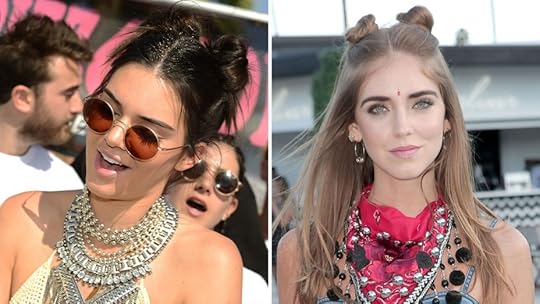
Kendall Jenner and Chiara Ferragni at Coachella.
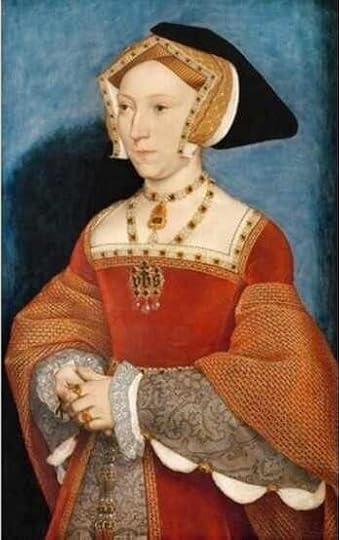
Jane Seymour, Queen of England. Oil on Wood. 1536, by Hans Holbein.
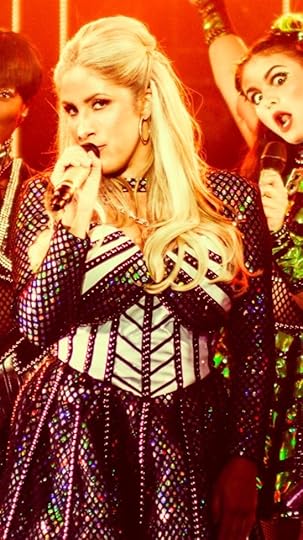
Jane Seymour, portrayed by Natalie Paris. (Photographer Unknown)
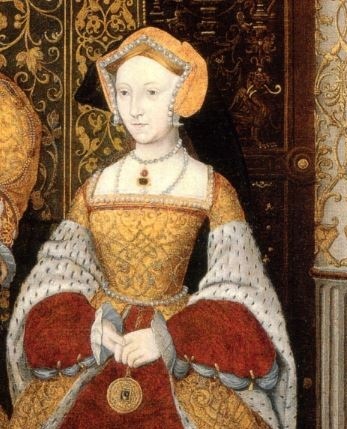
Jane Seymour, from “The Family of Henry VIII” c. 1543-1547. Unknown artist, after Holbein. Hampton Court Palace.
Jane Seymour, the only one he truly loved
(Rude.)
When my son was newly born
I died, but I’m not what I seem?
Or am I?
Stick around and you’ll
Suddenly see more
Jane Seymour was Henry VIII’s third wife and Queen of England from 1536-1537. She was his second English born spouse and the daughter of a courtier who was knighted by Henry VII. She had a much more traditional woman’s education than either Catherine of Aragon or Anne Boleyn and though she could read and write, she was better at household management and needlework. She was from a large family, which may have contributed to Henry’s interest in her, as presumably, she was as fertile as her mother.
Jane was definitely a maid of honor to Catherine of Aragon as of 1532, but may had been serving her for several years before that. She then went on to serve Anne Boleyn. The first reports of Henry courting Jane are from February 1536, about three months before Anne’s execution and indicate that Jane had rejected a gift from Henry. In March, he sent her another gift; she responded by saying that she had “nothing in the world but her honour, which she would not wound for a thousand deaths.” Jane eventually did accept a small portrait of the king, which she wore on a necklace. Henry had given a similar present to Anne during their courtship; it’s reported that Anne snatched the necklace from Jane’s throat when she saw it.
in April 1536, Jane’s brother and sister-in-law moved into Thomas Cromwell’s former chambers in Greenwich, which were connected to Henry’s apartments by a secret passage. Henry visited her there with her family as chaperones. Jane was kept away from court during Anne’s trial, but was betrothed to Henry only a day after Anne was executed. They were married within two weeks.
She had well-publicized sympathies with Catherine of Aragon and Princess Mary and took efforts to reunite Henry with both of his daughters. She was praised by various ambassadors and courtiers as being very gentle, peaceful, and meek (basically the polar opposite of Catherine of Aragon and Anne Boleyn).
Jane Seymour became pregnant in early spring 1537 and gave birth to Prince Edward on October 12. Later that day, she reportedly was sitting up in bed writing letters and received guests on the day of Edward’s Christening. However, she fell ill and passed away on October 24. It’s believed she died of puerperal fever, an infection that can occur after childbirth.
Henry wore black for months after Jane’s death and did not remarry until 1540. Years later, when a family portrait was painted for Henry VIII, the painting included Jane Seymour, her son Edward, and his daughters Mary and Elizabeth. When he died in 1547, he was buried next to Jane’s grave on his request.
Historical Influences: I’m not seeing much of an homage to Seymour’s portrait here, aside from slight similarities in the neckline and necklace line. Jane’s character is depicted with the longest skirt by far, which may be a reference to her meek reputation. She also has the heavy grommets seen in the other costumes, but in silver, rather than in gold. The white in the costume appears to refer to her peace-making efforts. Jane’s dress also has strong armor vibes, although I’m a bit unclear on what that could refer to.
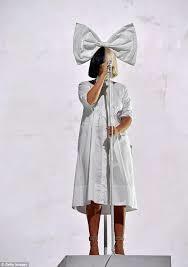
Sia
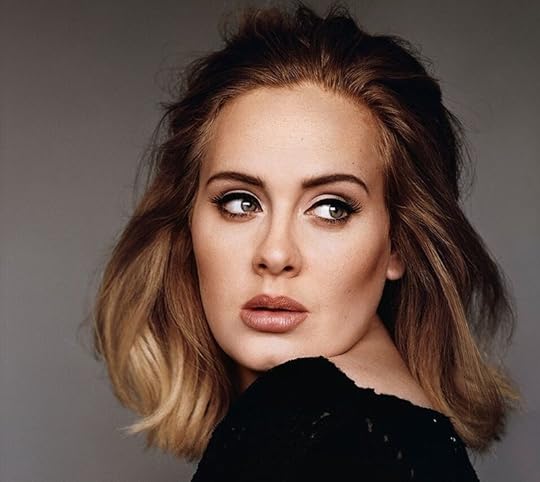
Adele
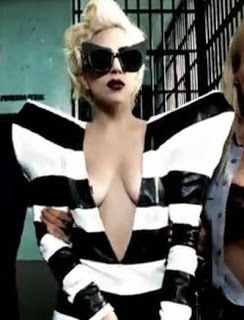
Lady Gaga in her music video for “Telephone”
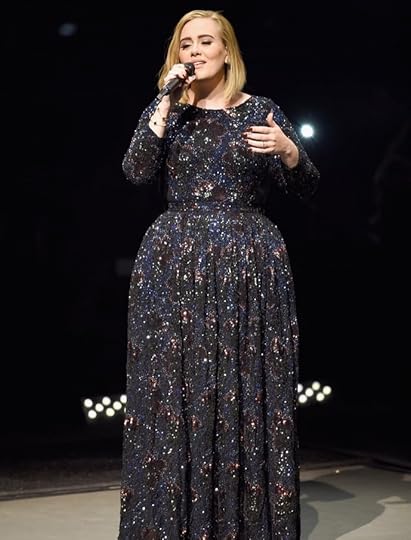
Adele
Pop Culture Influences: Adele, Sia, and Lady Gaga have been listed as inspiration for Jane Seymour in Six. Jane’s power ballad “Heart of Stone” has a definite Adele power ballad feel to it. The piano background is reminiscent of numerous Adele and Lady Gaga songs. The high whistle notes part at the end is a bit more Mariah Carey than any of these singers though, IMO; Gaga and Sia are both known for high /belting/ at the end of songs, but that’s not quite the same.
Adele is known for wearing a LOT of black (in one interview, she said she sometimes goes out wearing color and people don’t recognize her) and she often goes for long sleeves and classic silhouettes that emphasize her hourglass figure, just like Jane’s costume. Sia uses black and white in her wigs and costumes on a pretty regular basis.
I initially thought I’d have trouble finding Lady Gaga inspirations, but the prison dress outfit from the Telephone music video definitely seems similar to Jane’s strong black and white stripes ensemble, plus they both share that trademark light blonde hair. Jane’s pulled back hair with volume seems like a pretty clear Adele reference as well.
Accessories Note: Earlier photos of Jane show that her costume used to incorporate a black leather hair piece with little silver spikes, but that appears to have been removed at this point.
September 27, 2019
I've Learned SO MUCH from the By the Book Podcast!
I listen to numerous podcasts but one of my current favorites is the By the Book podcast! I discovered it earlier this year through an ad on the Freakanomics podcast (which my husband listens to obsessively) and was instantly HOOKED. I’ve listened to every episode since then (which is saying something since they have several seasons!
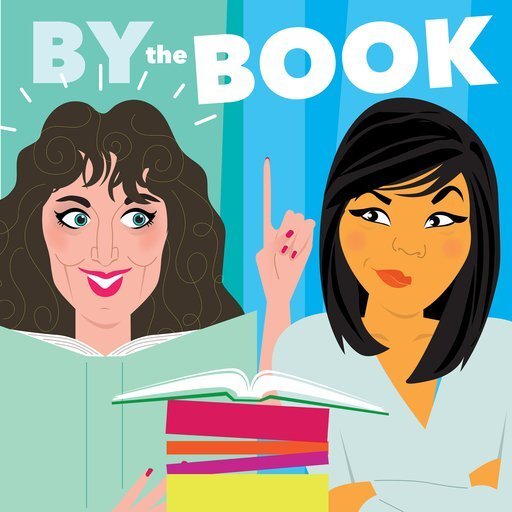
The premise of this podcast: The brilliant and hilarious Jolenta Greenberg and Kristen Meinzer read through a self-help book for every episode and try to live by it for two weeks straight. They chronicle their adventures with wit and thoughtfulness and I’m pretty obsessed. I’ve learned so much from so many episodes! It’s also helped me to be a lot more careful about my own self-help reading and encouraged me to take a closer look at the authors and what they’re really saying.
For example: The Miracle Morning book has personally really helped me in the past. After getting my depression under control (FISHER-WALLACE STIMULATOR, SERIOUSLY Y’ALL), The Miracle Morning has changed my life more in the past year than anything else! Going through the SAVERS approach regularly (silence/meditation, affirmations, visualizations, exercise, reading, and scribing/journaling) helped me remember that I have ALWAYS wanted to be a writer and got me on track toward pursuing that path really seriously. However, the By the Book episode on Miracle Morning pointed out a lot of issues with the book and its author and helped me realize that I had been doing a lot of “take what I want and throw away the bad” in my own approach to it. Which is totally fine. I still use it sometimes. But a lot of the advice in the book is kind of victim-blamey and makes me uneasy when you actually look at closely. So now I’m more careful about how I suggest that book to friends; I include a lot more disclaimers and points about how I actually use it.
By the Book has also made some really significant changes to my life in the past year! It’s inspired me to make numerous changes.
Here’s what comes to mind now (I may add to this later as I remember things or add more!):
Things I do now or have done because of the By the Book podcast: (links go to the episode on Stitcher’s website)
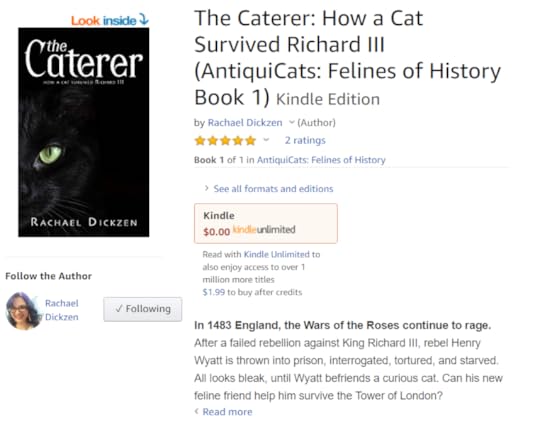
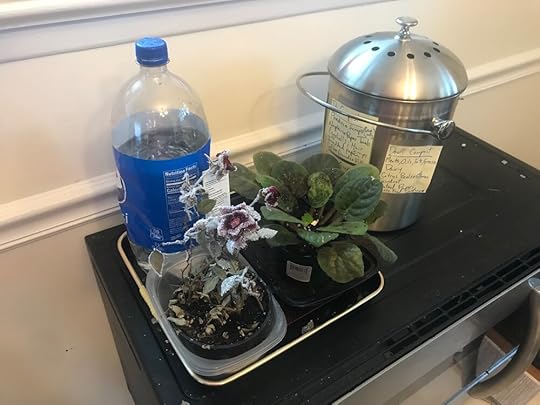
Look! Plants I’ve somehow kept half alive, plus an old soda bottle I now use to water indoor and outdoor plants, and our compost pail!
We now plan out our family meals ahead of time and try to do all the grocery shopping once a week. John and I pick and make the recipes together and have found it makes our life WAY simpler when we actually know what we’re eating at night. (From the “America’s Cheapest Family” episode)
I published a short story as an ebook on amazon. I had already written this story and submitted it to an anthology. When it was rejected, I thought - YOLO and decided to put it on Amazon as an experiment. It’s been fun! I’ve earned about $40 from it, which is cool. (From the “how to write an ebook that makes you money forever in 7-14 days” episode)
I’ve invited friends over to work at our house whenever they like. Not many people have taken me up on this, but I do love that as someone who teleworks full time and has a pretty big house, I can provide an escape for my student friends or other friends who work from home. (From “a girl’s guide to joining the resistance”)
I reuse and recycle more things, have started composting (blog post coming about this soon!), and make my own reusable wet wipes for cleaning. (“zero waste home”)
I focus on only saying nice and supportive things to myself. (“What to say when you talk to yourself”)
I try to use my phone less when I’m out and about (“bored and brilliant”)
I try to only check my email and social media twice a day. Honestly, I’m pretty bad about this, but just knowing it’s an option for days when I REALLY need to focus is good. I also now outsource time-consuming tasks i hate to people on Fiverr . I’ve found a cool personal assistant guy and have had him do some cost-comparison research tasks which have been really helpful! (“4 hour work week”)
So Kristen and Jolenta have only done one “diet” book and it had such a bad effect on Kristen that they don’t plan to do another one. This episode and a lot of their conversations in later episodes helped me come to grips with a lot of my disordered eating habits (I tend to either over-eat or under-eat, and neither is healthy) and develop a more healthy approach to my body. I don’t weigh myself any more and I don’t really plan to again; it’s highly triggering for me. Instead, I eat healthy most of the time, avoid too many processed foods, practice delaying my first meal until 12 pm or 1 pm (which effectively means I usually am intermittent fasting for 14 hours), and exercise regularly. And that’s enough for me. As long as I’m feeling healthy and happy with how I look, I don’t need to know my weight; it’s just not important. Thanks K&J for helping me realize that! (“French Women Don’t Get Fat”)
I’ve worked to define what types of clothing and accessories are and aren’t my style and have been donating or selling things that aren’t my style. If I go shopping now, I’m much less likely to impulse buy anything, as I know exactly what I like and what looks good on me and I’m not willing to spend money on things that don’t fit in those categories. (“curated closet”)
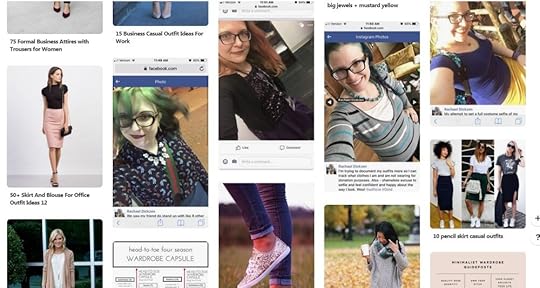
A snippet of the pinterest board I made for the Curated Closet.

Look at these plants I’ve managed not to kill yet!
I actually let myself actually watch TV without doing work sometimes. I mean, not all the time, I usually am working on some craft or blog post or something if I watch TV, but sometimes! (“Pantsdrunk”)
I’ve really tried to walk outdoors more and keep my house plants alive more consistently. I re-planted our dead herb garden and have managed to keep 4/5 plants alive for the last few months! (“nature fix”)
I’ve let go of some project ideas that were GOOD but just not for me. This book specifically talks about letting go of the ideas that aren’t a match for you so they can go “find someone else” they’re better suited for. This was how I finally let go of the idea of writing a non-fiction book about marital surnames. It still fascinates me and I think it needs to be written about, but I just don’t have the passion to pursue that myself. I prefer my fiction writing. (“Big Magic: Creative Living Beyond Fear”)
I had actually already “konmari-ed” several parts of our house but this episode has helped me retain some of the ideas - specifically, does this item give me joy? If not, I should donate it and let someone else enjoy it. (“The Life-Changing Magic of Tidying Up”)
September 12, 2019
EWF Unpacking: Polish Your Pitch and Publishing Masterclass
I’ve been pretty dilatory about posting up these notes, but I’m slowly getting them out there! Here’s some more useful wisdom from the Emerging Writers’ Festival!
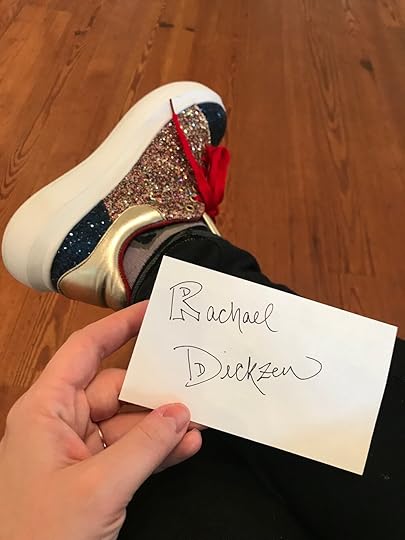
I took very few photos at the festival, but I did manage to get this one of my name tag and my awesome shoes.
Polish Your Pitch - Class by Jennifer Baker (publishing professional of 16 years, host of the Minorities in Publishing podcast, contributing editor to Electric Literature, essayist)
I have pages and pages of notes from this class taught by Jennifer Baker, including some very specific suggestions she made for a story I’ve been trying to pitch. Here are some of the highlights though:
First, follow the rules on pitching. Actually read the publication’s submission guidelines and make sure you know what type of work they’re working for. It’s a waste of your time and theirs if you pitch something that doesn’t follow their guidelines and/or is just totally wrong for their publication.
Your article topics need to be specific and interesting. Your goal is to get a “I haven’t heard this before” from the person you’re pitching to. If you’re writing on a common topic, make sure to specify what makes your spin different and unique.
If you can’t find a person’s name or can’t figure out how they identify, it’s okay if you just say “Dear Editor.” Just don’t make assumptions!
The editor is coming at your piece with a few things in their minds: “Can you do the thing you’re saying you can do?” “Is it worth my time and effort to pay you?” “Is the structure and voice of the piece there?” You want to be able to answer all these questions in your pitch. The more fleshed out and structured the idea, the less work the editor needs to do to get it up to par.
If someone rejects your pitch, don’t take it personally! Jennifer said: “As an editor, I have rarely ever NOT taken a pitch because of someone’s bad writing. I don’t believe in bad writing, but I do see unfocused writing.”
Publishing Masterclass - Class by Jane Friedman (20 years of experience in publishing industry, author of The Business of Being a Writer and The Authors Guild Guide to E-Publishing)
I actually had to leave this class 1/3 of the way through to go volunteer for the festival in another location, but I still learned SO MUCH. I’m really glad I got to go for at least that much.
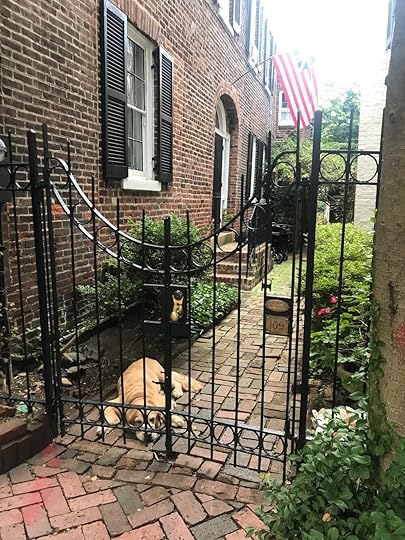
I found this sweet pupper hanging out in Old Town Alexandria near the festival while walking between events one day.
To submit to publishers, you need:
A finished manuscript for a fiction book
A book proposal for a nonfiction book
For a memoir, you probably should have both a finished manuscript and a book proposal, as some publishers will want one or the other and plenty will want both.
Before you submit, you need to make sure your manuscript or proposal is the best you can make it. You need to resolve all the problems or hire someone to do it for you. No one EXPECTS you to hire an editor for revisions, but it’s certainly an option.
If you want a large/mid-size publisher, it’s a good idea to get an agent.
It’s really important to define the genre of your book so you can find the correct agents and publishers. This can be hard since some book genres are pretty nebulous.
For example, “Literary fiction” is sometimes publisher code for “will not sell.” However, once it makes the best seller list, a literary fiction book’s genre tends to magically change to “mainstream fiction.” (There are no particular requirements for either of these genres).
You can sometimes get away without picking a genre for your book by comparing it to another work instead, but that doesn’t always work.
Hard to sell works: Poetry, collections, multi-genre work, “hard to categorize” books
Even if your work is “hard to categorize,” just label it something. People run in the opposite direction at the sound of “hard to categorize.” “If you don’t know, they won’t know either.”
Projects that are more commercially viable:
Fiction - Genre, commercial, or mainstream narratives of about 80,000 words. You can go as low as 50,000, but that’s as low as you can go. Once you reach 100,000, you’ll get some pushback about it being too long or needing more editing.
If you’re trying to get a nonfiction book published by a large publisher, you need a platform. Your visibility and authority can matter as much as the content. They expect you to bring the audience to the publisher, not vice versa.
if you’re a journalist or professor or have some sort of career that gives you credibility on a topic, that can help you with your nonfiction author platform.
Less commercially viable projects:
Narratives that are 120,000+ words.
Children’s picture books, cookbooks, travel, short fiction, essay collections, poetry, anthologies of any kind
September 11, 2019
Fixing Up Split Headphone Wires with Yarn!
Oh oh I actually came up with the solution to this problem all on my own and I am DELIGHTED at how well it worked!

So I tend to be rather hard on my headphones and as a result, I don’t spend much money on them. I had a cheapo pair currently that work fine, however, the connection between the two wires leading up to the headphones split, so they were constantly getting tangled. It was driving me pretty crazy.
I’m simultaneously learning to crochet and have a lot of yarn around, which gave me an idea. What if I just added some yarn into the wires and then braided the three pieces (two wires, one yarn piece) together? That would combine them all again and reduce the tangling!
It honestly worked better than even I could have anticipated! And it made my headphones look really unique and fun. I’m really happy with the result.
Here’s how I did it!
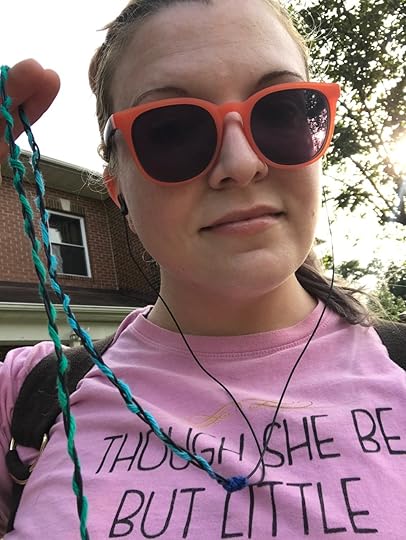
There was one tiny clasp still holding the two split wires in the headphones together. I cut that off with some scissors, as I’m about to render it useless!
I took some yarn and tied it securely to the base of the headphones using a few knots.
I measured out the yarn against the headphones and cut it to the length of the entire cord. This will actually be too long, but it’s easier to trim it later than add more length if you cut it too short.
I channeled my elementary school self and braided the wires together with the yarn! (making friendship bracelets was the cool thing on my school bus! I carried around the cutest little Cat in the Hat bag full of embroidery thread and safety pins to pin the braid to the back of the seats while I was working on it. Ahhh nostalgia.) I held the end of the braid with my chin, but you could also clip it or hold it down with some heavy books if you like.
When I was almost done, I tried on the headphones to ensure I had enough length of two split wires for my head and neck, then tied off the braid below that spot.
And there you go! It’s been working perfectly since I braided it. :)
September 9, 2019
#ShakespearesPlaylist: The Taming of the Shrew
So I LOVE finding songs to fit the mood of #Shakespeare plays. Basically every time I hear a song I love on the radio, I think about how I could fit it into a production. I can’t help it. My brain just does that, which is funny, because I’ve only directed one production (my own one-act) and questioned myself and my abilities the entire time, so I don’t necessarily see myself directing anything else any time soon, but I just like to dream about the music anyway.
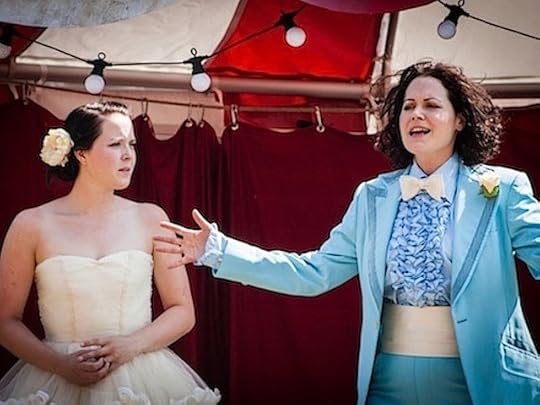
The Globe Theater cast of The Taming of the Shrew from 2013 - photo from https://thehoneycombers.com/singapore/the-taming-of-the-shrew/
I’ve decided to play with this habit of mine more and make full-fledged Spotify and Youtube playlists for each play by Shakespeare, under the umbrella name and hashtag #ShakespearesPlaylist .
Quick Wikipedia summary: The Taming of the Shrew depicts the courtship of Petruchio and Katherina, the headstrong, obdurate “shrew” in the title. Initially, Katherina is an unwilling participant in the relationship; however, Petruchio "tames" her with various psychological torments, such as keeping her from eating and drinking, until she becomes a desirable, compliant, and obedient bride. The subplot features a competition between the suitors of Katherina's younger sister, Bianca. who is seen as the "ideal" woman. The question of whether the play is misogynistic or not has become the subject of considerable controversy, particularly among modern scholars, audiences, and readers.
I chose Florence + The Machine’s Kiss with a Fist to represent the domestic abuse prevalent in Taming of the Shrew. This is the part of the play that makes everyone uncomfortable, but it’s such an integral part to the plot that you really can’t remove it or gloss over it without changing the story completely. This is one of those problem plays that I think needs to be done carefully and respectfully, with a lot of conversation and care. Sure, perform it, but make sure to discuss the problematic aspects of it in your program or in a post-show discussion.
Husband John and I saw a version of it at The Globe in London in 2013 that featured an all-female cast; that choice retained the original story while portraying it in an explicitly feminist way that helped me see it in a really different way. It was very affecting. Because of those problematic aspects though, I personally have never been involved in a production of it nor have I seen many productions of it. One study (reported on Priceonomics) found that it was the fifth most popular Shakespeare play (in terms of professional performances by major theater companies between 2011-2015; this kind of surprises me? It is quite possible though that I’ve just happened to live in areas where it’s just not commonly performed. Plus, I mostly work with and am around community theater productions, and they seem to be slightly less willing to put on controversial plays (just my observation, not sure why).
I should note- Kiss with a Fist is not actually about domestic violence. Florence Welch explained the meaning of the song on her blog: “It is about two people pushing each other to psychological extremes because they are fighting but they still love each other. The song is not about one person being attacked, or any actual physical violence, there are no victims in this song. Sometimes the love two people have for each other is a destructive force. But they can't have it any other way, because it's what holds them together, they enjoy the drama and pushing each other's buttons. The only way to express these extreme emotions is with extreme imagery, all of which is fantasism and nothing in the song is based on reality. Leona Lewis's ‘Bleeding Love’ isn't actually about her bleeding and this song isn't actually about punching someone in the mouth." (I grabbed this explanation off Wikipedia)
Joan Jett’s Bad Reputation is a bit of an obvious choice for representing a woman who refuses to conform to society’s expectations of her, but I love this song and had to include it anyway.
Yeah, that’s a really short explanation of that, but I really can’t think of anything else to say. Joan Jett is awesome.
Etta James’ It’s a Man’s Man’s World addresses the gender dynamics of the play, as ultimately Katherina has little choice when it comes to her husband. Although Katherina does ultimately “agree” to marry Petruchio when he shows himself willing to counter her sharp wit, she has no ability to stop the ceremony when Petruchio hits the priest and drinks the communion wine and is completely helpless when Petruchio abuses her by withholding food and gaslighting her until she does his bidding. He shows off her “tame” self at the end to the other men. The setting of this play truly is “a man’s world” and Katherina is trapped in it.
Finally, since these songs have mostly been pretty dark, I’m ending on a lighter note with Letters to Cleo’s I Want You to Want Me. This cover was prominently featured on the 10 Things I Hate About You soundtrack. 10 Things is a loose adaptation of Taming of the Shrew and also coincidentally is one of my favorite romantic comedies of all time, probably because it came out in 1999 when I was 11 and thus was one of the first modern romantic comedies I ever actually watched.
September 7, 2019
The Best Long-Lasting Lipsticks: If You Love the Look but Hate Reapplying
So some friends asked me for long lasting lipstick recommendations and I'm happy to oblige! These lipsticks work well for anyone who loves makeup but hates spending more than a few minutes applying it.
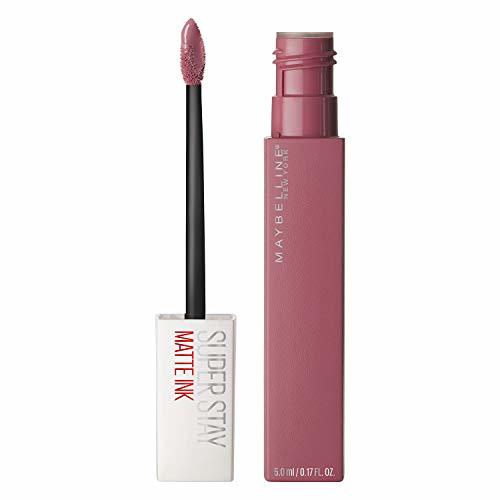
Maybelline SuperStay Matte Ink Liquid Lipstick, Lover, 0.17 fl. oz.
Maybelline
So currently, I telework full time from home and don’t even put on makeup most days. I just use my basic skin routine of cleanser, toner, acne products, moisturizer, and Vaseline petroleum jelly at night (on my forehead and lips) - I really keep it super simple. And my skin generally looks great as a result! So when I /do/ leave the house, I generally just put on some lipstick and peach blush, perhaps a little concealer if I’ve been stressed out lately. If I’m feeling ambitious, I’ll put on some eye shadow and mascara, maybe eye liner. But I definitely have more lipstick than any other product and wear it most often!
I /only/ wear long-wear lipstick because I despise smudgy lipstick and leaving lipstains on glasses. I’ve honestly tried using fancier lipsticks before; I’ve prepped my lips with a sugar scrub and used a lip primer and lip liner and blotted three times and used a setting powder. It never works for me! And it’s way more work than it’s worth for the final result. So now I just stick to the long-lasting lipstick I know and love.
Two tips on long-lasting lipstick:
1. Use Vaseline petroleum on your lips at night to keep them moist and happy. These products can often be drying. Vaseline can also help remove the lipstick!
2. The secret trick to keeping lipstick off your teeth- After you apply, just put your thumb in your mouth, close your lips around it, and then pull it out. You have to wipe your lipstick off your thumb then, which is annoying, but I’ve literally never found anything else which works better.
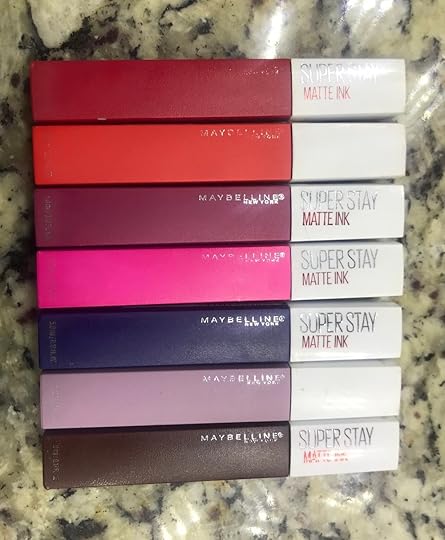
So my most commonly worn lipstick brand these days is Maybelline SuperStay Matte Ink (pictured). The colors shown here are: Pioneer, Heroine, Artist, Romantic, Explorer, Philosopher, and Protector.
I love this brand! It runs under $10 and comes in a lot of different colors - from classic or bold, to neutral or more out there shades. I should have even more than are pictured here, I just can’t find one or two of them right now, as I usually always have one in my purse when I’m out and about.
I have gone to dentist appointments wearing these shades before and they don’t budge; my dental hygienist has actually asked me what brand it was. They’re great! And you can also mix them together for an in-between shade if you’re careful - I apply the shades directly over each other on my lips and then rub it together to mix it and cover all the lines. I of course use a cloth to sharpen all my edges.
In addition, this brand has a great applicator that has a sharper edge than most do; i find it easier for making a sharp line. It also smells AMAZING. I think they put vanilla in the formula or something.
I also recently tried out the Maybelle Super Stay Ink Crayon Lipstick but honestly, I wasn’t impressed. It didn’t last nearly as long as the regular formula.
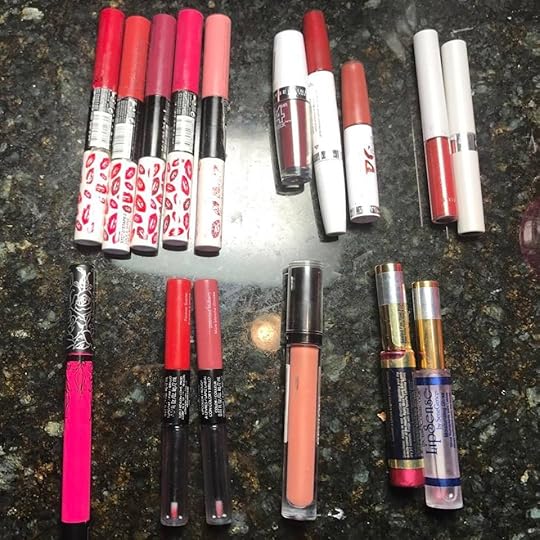
This pic shows my favorite lipsticks and most commonly worn AFTER my Maybelline:
First: my Rimmel Provocalips (upper left corner). These colors from left to right are Play with Fire, Heart Breaker, Kiss Fatal, Little Mink, and Dare to Pink.
Next going counter clockwise: the shorter purple lipstick is Maybelline 14 hr in Wine and Forever (my darkest lipstick!); then two Maybelline Superstay 24 Colors - All Day Cherry and Timeless Toffee.
Upper right: CoverGirl Outlast All Day Two Step Lipcolor in Eternal Flame.
Bottom Right: Lipsense by Senegence long lasting liquid lip color in B. Ruby with Glossy gloss.
Next to that on the left is Revlon Colorstay Ultimate in Buffest Beige (my go to nude lip color). I use this one if I’m wearing stage makeup and playing a dude.
Next to that: Revlon Colorstay in Unlimited Mulberry and Forever Scarlet.
Finally, bottom left is Kat Von D everlasting liquid lipstick in Backstage Bambi.
I would recommend all these brands with different levels of caution; all of them will last longer than your standard cream lipstick. Almost all of these can be bought at a drugstore or Target and honestly those tend to work best for me (I think my lips just adhere better to cheaper brands?). The Kat Von D is the most expensive by far; this shade lasts maybe half a day for me, but I've been told that this particular color is the hardest to work with from that line so I'm hoping to try another shade in the future to get a better idea of its quality.
The Lipsense is very different from the rest; it dries very quickly and requires lots of thin layers and a gloss to work. It's a bit tricky but I've found with regular lip scrubs that it withstands most of the day. It can only be bought from independent sellers and not from retail stores; if you're interested in it I can give you my contact. :)
As always, let me know if you have any questions! I'm happy to help!
September 3, 2019
Easy No Heat Hair Styling For Fine-Haired Girls
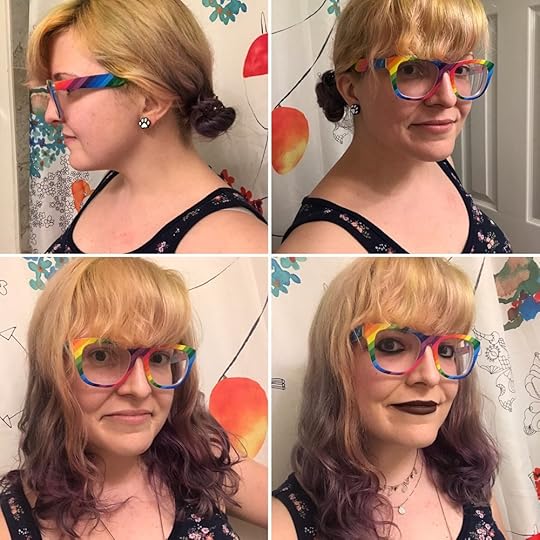
Half dry hair in low buns at top, lower left shows the hair immediately after several hours drying in the low buns. lower right shows the final look after it’s all dried post-makeup.
Since I bleach my hair before i dye it all the colors of the wind, I try to really baby it at other times.
I rarely use heat styling on my hair- maybe once a month I’ll use a curling iron and a blowdryer maybe once every two months. But my hair tends to lie rather flat if I don’t do /anything/ with it, so I use a lot of no heat styling tricks. Usually, I just style it by waiting until it’s half dry after a shower, and then putting it into one of a few hair styles so it can gain some shape and texture as it dries the rest of the way. This doesn’t work on everyone, but if you have naturally straight hair with a similar medium-fine hair diameter like I do, it works great! (If you’re not certain what type of hair you have, this article on Headcurve can be really helpful! I have a 1b hair type, meaning it’s fine and generally straight, but not so fine that you would see a lot of scalp showing through.)
My current favorite no heat style is two low buns in the back. I specifically also twist the hair as I’m putting it into the bun. I then either sleep on it or chill for a few hours while I’m working.
Once I take it out- voila! Fun curls and texture. As you can see in the picture, it’s still just a little damp when I take it out, so I finger comb it and zhush it a little. By the time I’m done with my makeup, it’s all dry and looks great! It’s really simple and I quite like it. :)
I personally don’t tend to use a lot of product on my hair unless it’s absolutely necessary. I don’t even usually use frizz free serum on my hair, as it can look greasy really quickly. I’ll often just put a little lotion on my hands at the end of my prep, rub it in, and any small amount that’s left, i’l just lightly finger comb through my hair - ends first, than just a very light hand on my roots.
September 1, 2019
#ShakespearesPlaylist: Comedy of Errors
So I LOVE finding songs to fit the mood of #Shakespeare plays. Basically every time I hear a song I love on the radio, I think about how I could fit it into a production. I can’t help it. My brain just does that, which is funny, because I’ve only directed one production (my own one-act) and questioned myself and my abilities the entire time, so I don’t necessarily see myself directing anything else any time soon, but I just like to dream about the music anyway.
I’ve decided to play with this habit of mine more and make full-fledged Spotify and Youtube playlists for each play by Shakespeare, under the umbrella name and hashtag #ShakespearesPlaylist .
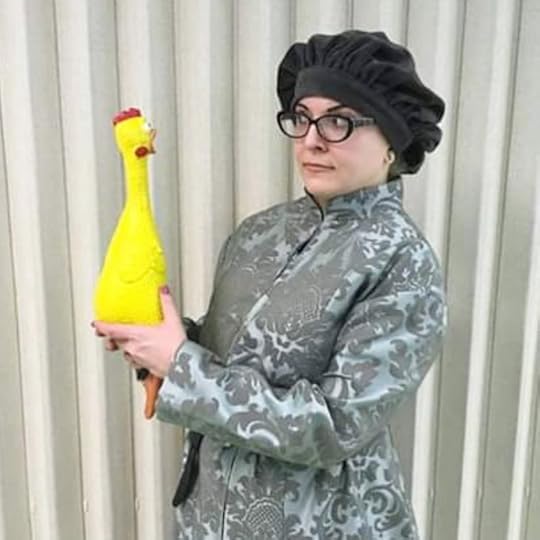
Quick Summary of the Play from Wikipedia: “Set in the Greek city of Ephesus, The Comedy of Errors tells the story of two sets of identical twins who were accidentally separated at birth. Antipholus of Syracuse and his servant, Dromio of Syracuse, arrive in Ephesus, which turns out to be the home of their twin brothers, Antipholus of Ephesus and his servant, Dromio of Ephesus. When the Syracusans encounter the friends and families of their twins, a series of wild mishaps based on mistaken identities lead to wrongful beatings, a near-seduction, the arrest of Antipholus of Ephesus, and false accusations of infidelity, theft, madness, and demonic possession.”
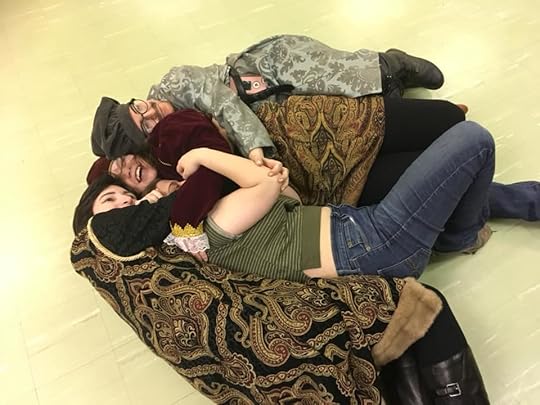
I actually acted in a minor role in Comedy of Errors earlier this year! It’s an extremely silly play, and probably one of my least favorites, but the director and assistant director had a really fun vision for it that included lots of slapstick and physical comedy, plus a prominently featured rubber chicken. I got to wear a lovely costume and a ridiculous mustache and got to do some really fun comedic acting just reacting to the shenanigans aroudn me! Here’s a publicity pic of me for it (pre-mustache):
Plus I just got to work with the best people. Here are a couple of us in a ridiculous cuddle pile on the floor backstage, lol.
ANYWAY, when I think of this play, I tend to think of exceptionally ridiculous songs or songs about “double vision” or confusion. So I’m putting in Yakety Sax, the classic slapstick song, Double Vision by Foreigner to refer to the Twins/mistaken identity plot, and One Week by BareNaked Ladies to evoke the shenanigans feel of the whole play. I’m also throwing in Crazy by Gnarls Barkley (a cool slowed down version!) in here to refer to every character’s mutual feeling of “What is going on here? Am I going mad?” by the end of the show".
What songs would you add to this list? You can suggest them here or on Twitter at #ShakespearesPlaylist :D
August 27, 2019
A Diet App for Children? Are you Friggin Kidding me?
I just found out that the Kurbo by WW app exists from this Atlantic article (which has a great overview of the app and the issues with it) and I'm slightly horrified. It’s aimed at children 8-17. Apparently you need to sign up /with/ a parent if you’re 13, but in my experience, age restrictions on tech like that are super easy to get around. And even if a parent DOES sign you up, are they realistically going to be there with the kid at every moment supervising them on the app?
The basic idea behind the app (putting foods in green, yellow, and red categories based on nutritional value and encouraging users to eat yellow and red in moderation) isn't /terrible/ but marketing it to children as opposed to parents is pretty...awful. And to kids as young as *8*? Are you friggin kidding me? I've used the WW program before and found it pretty positive and helpful (with just a lot of caveats in there about my own depression and ADHD issues which sticking to any healthy diet long term difficult), but I'm pretty appalled they're doing this. I could /maybe/ see the idea behind marketing it to teenagers 15 and up with their own access to money, but from just a basic administration issue, the vast majority of kids don't buy or prepare their own food?
Plus this whole thing just seems really problematic and trigeringg. Even WITHOUT the 24/7 news cycle and social media of today, I remember being unhappy with my size and my weight starting at least back to age 9. I clearly remember the first time I looked at a picture of myself and hated the way I looked (it was from summer camp, I was sitting on a horse and wearing black shorts and a colorful shirt and I thought my legs looked "huge"). I am much happier and more confident with myself, my life, and my appearance than I ever was as a child, but I STILL fight disordered eating habits all the time. Aiming a weight loss app at a child is just one of the worst things I can imagine. Let. Them. Be. Children. And don’t give them a friggin complex over their appearance at an age that’s so difficult already.
Emerging Writers Festival Unpacking: Keynote, Fiction Intensive, and Against the Algorithm
So going over all my notes from the Emerging Writers Festival is helping me recap everything I learned and make sure I put it into practice in my own writing life and practice. In addition, I’m hopeful this might be helpful for others who weren’t able to attend some of the sessions, for whatever reason.
So here are some tidbits and wisdom from the first few sessions I attended at the festival!
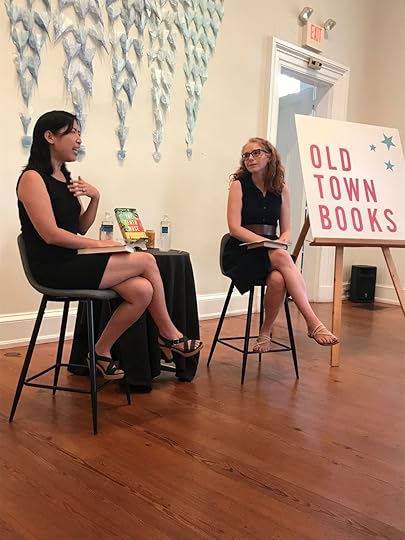
Catherine Chung and Tayla Bruney
The Keynote with Catherine Chung. She talked about her second novel, The Tenth Muse, with moderator Tayla Burney (a journalist and book reviewer for the Washington Post. She also writes a weekly email newsletter of author events and literary happenings around DC called Get Lit DC; you can subscribe to that here).
Cathy said that she had to rewrite her novel several times. “I had to let my narrator have this amazing life. I found sometimes I was the oppressive societal force holding my protagonist back.”
She said that she’s had writing retreat experiences where they just feed and house you and you just write all day. “It’s the most quixotic, ecstatic writing experience where you never have to leave the world you’re writing in. It ruins you for life.”
At one point, the company she worked for actually did a Christmas skit making fun of her ambition to be a writer. [Isn’t that SO SCREWED UP, seriously??]
“Writing rules are silly.” One professor claimed that if you don’t write every day you’re not a writer, but she said that while she was researching for her second novel, there were maybe years where she went without writing. She’s clearly still a writer.
For her first novel, she wrote all the time and threw out at least 1,000 pages as part of her process. It seemed like she was just accumulating pages and then throwing them away. But eventually it all came together and she figured out the structure. Her second novel was more structured from the beginning and was a different beast entirely.
A friend gave her a headsup before her novel came out: “Every writer gets depressed when their book gets published,” regardless of how well it does in the world or anything. Because you’re going from living entirely in your head to releasing it and waiting to hear what people think of it. Waiting is a terrible feeling. So ahead of her second novel’s release, Cathy decided just not to care.
She named the protagonist of her second novel Katherine as a joke, since so many people thought her first novel was an autobiography. However, it kind of backfired because many people still thought her second novel’s protagonist was autobiographical. At one point her wikipedia said that she was a 74-year-old woman; she was kind of sad when it got corrected.
From novelist Catherine Chung’s Fiction Intensive Workshop:
Cathy talked a bit about how she found it really interesting to see what people believe and what they don’t believe, as all of fiction is about making things up that people go along with. Sometimes we’re willing to believe the most ridiculous things, and in the current political climate, there’s a constant debate about what is true and false. What determines the stories we believe? What determines the stories we tell and are allowed to tell? (I believe most of the statements in this paragraph are actual quotations from her, but I didn’t notate it well enough in my notes to know for sure, so I’m paraphrasing a bit.)
“When you figure out the technical parts of a story, everything else falls into place” – who is the narrator, the audience, what is the shape of the audience.
She had us do an exercise where we wrote a letter to someone close to you in which you told them something you’ve never told before. As Cathy said, this premise sets up the central tension of a story from the very beginning. “There’s a reason you haven’t told them this thing before, and there’s a reason you’re telling them now. There’s a potential of how it will change everything.” When there’s an audience member for a story that’s very specific, it puts the tension of the story at the forefront. She pointed out that we don’t usually think about the fact that the speaker in a story is different from the author, and the intended audience and the actual audience are not always the same. Once she started thinking about this, it helped her unlock some things she’d been working on for her first novel.
Cathy said her first and only college writing professor said you have to be absolutely subjective about everyone you write. You have to be able to see it from their side, no matter how horrible they are. But you also have to be absolutely objective about yourself.
Against the Algorithm Panel with Lupita Aquino (co-founder and co-moderator of the LIT on H St Book Club at Solid State Books, instagram book reviewer), Amanda Nelson (executive editor of Book Riot), and Kendra Winchester (co-founder of the Reading Women podcast). My notes from this were scribbled into a tiny notebook I bought last minute at Old Town Books while my laptop was charging, so they may not be as detailed or as…in complete sentences as other notes. :)
Panelists gave some great advice about the dos and don’ts of author marketing:
Lupita - Engage with people before asking them for a favor or a review. And pay attention to what types of books people are into.
Kendra - She suggests engaging in Middle Reader Thursday or other events designed to bring attention to your books. There are lots of hashtags and discussions out there particular to specific genres. You can even reach specific agents this way sometimes. She also suggests you experiment with your marketing; don’t be afraid to be imperfect.
Amanda - Be a community member before you start asking for stuff. Find book writers that write about your genre and reach out to them directly. Writers LOVE to hear from authors.
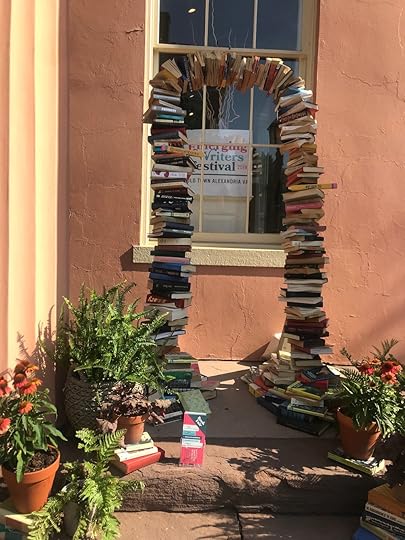
I basically didn’t take any photos on the Saturday of the writing festival at all except this one.
Regarding diversity in publishing and books:
Amanda - publishing as an industry is overwhelmingly white women at lower levels and white men at the higher levels. The inherent structure is racist and sexist. Her company has a diversity mandate where 30% of their reviews have to be of works by POC authors. They’re very strict about it
Lupita - Online, you notice the diversity issues more. We need the options.
Amanda- If you say “I just want a good story,” you're saying you just want to read what’s marketed to you. And those books are by authors who are overwhelmingly white, male, and cisgendered.
Kendra- You have to work to find the books sometimes and represent them. We need to see more people with disabilities in them. We need more than just Darcy’s cousin and a woman in the attic. She suggests following amazing women as well to learn from them.
Moderator Allison Punch - wants to make a distinction between what’s getting buzz and what’s actually written. People of Color have always been writing; we’re just now hearing about them.
What they do to help underrepresented authors
Amanda - Donates ad campaigns to some independently published books.
Kendra - a snowball effect can really help.
Amanda - looks out for debut authors in her marketing and tries to promote them.
Kendra - Points out that she thinks it’s unfair to debut authors that we expect them to be perfect. They need room to grow and become better.
If you want to become a book reviewer on social media
Kendra - be consistent with your postings
Amanda - have an interesting angle to it. Don’t just post a photo of fairy lights as your cover picture. Like she follows an instagram that only posts library books - she loves that, as it brings out books that are older. Do something unique.
How to support books besides tweeting and reviews:
Amanda - pre-orders! for libraries even, creates buzz
Kendra - create an evergreen post of a list of books - one of their most popular posts ever still is about Muslim women authors.
Lupita - pre-order giveaways
Amanda - pre-ordering from independent bookstores
Pitching to reviewers
Kendra - be specific and complimentary. Show familiarity with the reviewer’s work and guidelines.
To avoid drama on social media
Lupita - Set boundaries - practice self care
Kendra - ignore the drama and go to the people that support you
Amanda - Remember your job and ignore the rest. Avoid the petty crap.



